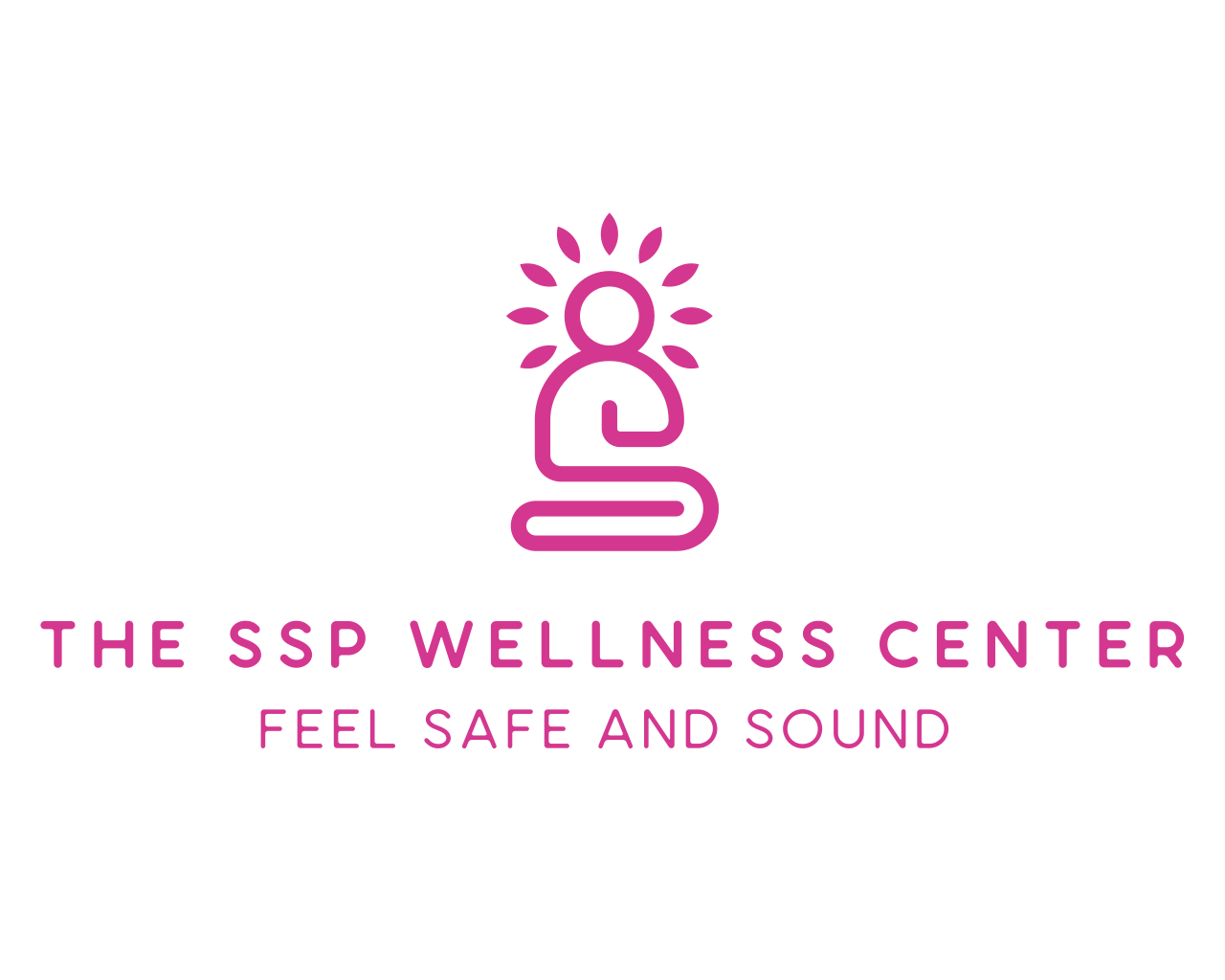If you’ve been scouring the internet trying to make sense of the Safe and Sound Protocol (SSP), you’re in the right place. Maybe you’ve heard whispers about this magical music therapy that can calm your nerves, ease chronic pain, help with anxiety, or even make you feel more connected to others.[*] But what exactly is it, and how does it work?
In this article, we’re diving deep into the SSP world. We’ll break down what the SSP is in simple terms, explore the science behind it, and answer all those burning questions you’ve got. By the end, you’ll have a clear understanding of whether SSP might be the game-changer you’ve been looking for.
What Is the Safe and Sound Protocol in Simple Terms?
First things first—what does SSP even stand for? SSP means Safe and Sound Protocol. In the simplest terms, it’s a powerful, therapist-led listening therapy that uses specially filtered music to help regulate your nervous system. Think of it as a workout for your ears and your nerves, designed to make you feel safer, calmer, and more socially connected.
But don’t confuse it with binaural beats or other chill tunes you find on YouTube. While those sounds aim to relax specific brainwaves, SSP’s music creates actual biological changes by stimulating your vagus nerve.
Who Created the SSP?
The SSP was developed by Dr. Stephen Porges, a renowned psychologist, professor of psychiatry, and Director of the Kinsey Institute Traumatic Stress Research Consortium. He also created Polyvagal Theory. Poly-whatty? Don’t worry, we’ll explain that next.
After decades of research into how our nervous system influences emotions and behavior, Dr. Porges created the SSP to support people dealing with chronic stress, trauma, anxiety, and more by “resetting” their nervous system.[*]
What Is Polyvagal Theory?
Okay, big word alert: Polyvagal Theory. But don’t worry, it’s not as complicated as it sounds. Essentially, this theory explains how our nervous system responds to stress and safety.[*][*]
Polyvagal Theory tells us that our body has different “gears” or states:
- Ventral Vagal State (Social Engagement): When you’re feeling safe and connected, you’re in this state. This is where the magic happens—social engagement, joy, and connection. When our ventral vagal system is healthy, we read our environment correctly, moving into other states as needed.
- Sympathetic State (Fight or Flight): If your brain senses danger, you shift into this gear. Your heart races, and you’re ready to either fight off the threat or run for it.
- Dorsal Vagal State (Shutdown/Freeze): If things feel overwhelming, your body might hit this mode. It’s like slamming on the brakes—your system slows down, and you may feel disconnected or frozen.
You might recognize these states and notice when you enter them. It’s normal to move in and out of them throughout the day. The problem arises when we get stuck in the sympathetic or shutdown state.
Still with me? There’s more.
Neuroception and Social Engagement
We’re constantly scanning our environment, often without realizing it, looking for safety or danger. This is called Neuroception.[*]
When neuroception goes haywire—due to chronic stress, illness, or trauma—we start misinterpreting social cues and other signals in our environment as dangerous. And this is when we get stuck in fight-or-flight or shutdown mode, sometimes for months or even years.
And guess what? That ain’t good for you.
Our bodies are wired to find safety in connection with others. This is what we call the social engagement system.[*][*] When it’s working well, we feel safe, can read our environment accurately and shift between nervous system states as needed.
But when we’re stuck misinterpreting signals, it’s a recipe for chronic illness, mental health problems, and difficulty maintaining safe relationships.
What Does this have to do with SSP?
The Safe and Sound Protocol (SSP) helps to re-establish your sense of safety by “resetting” your vagus nerve via specially filtered music. If you’re wondering what the hell a vagus nerve is, I cover that next.
These cues of safety help to restore your social engagement system, so your nervous system can move smoothly between states—creating a more resilient nervous system that is better able to handle stress. And this sets the stage for deep healing.[*]
If you’re a glutton for the science, you can learn more about Polyvagal theory here.
The Science Behind SSP—In Easy Terms
So, how does listening to music help your nervous system? Great question!
It’s all about how the sounds interact with the vagus nerve and your middle ear. The Safe and Sound Protocol (SSP) uses specially filtered (and fun) music designed to stimulate the vagus nerve.
It does this by engaging the muscles of your middle ear, giving them a little “workout”. Cute, huh? This in turn stimulates the vagus nerve.
Oh, and just so you know: The vagus nerve is the longest nerve in your body, running from your brain all the way down to your gut, and it plays a huge role in how your body responds to stress and relaxation. A key player in your parasympathetic nervous system (the part responsible for calming your body and helping you recover from stress), it also controls things like your heart rate, digestion, and even your mood!
Here’s the cool part. The SSP music is filtered to focus on mid-range frequencies, associated with feelings of safety. These frequencies are similar to the tones of a calm speaking voice or a mother singing a lullaby.[*]
Higher or lower tones—like sirens, loud bangs, or screaming—are linked to danger. So by tuning in to the mid-range frequencies of the SSP, your nervous system starts to shift away from a constant “threat-seeking” mode.
For someone stuck in fight-or-flight mode, this can be a game-changer. Over time, listening to SSP music helps retrain your nervous system to respond more appropriately to your surroundings. Instead of feeling constantly on edge, you start interpreting your environment as safer—reducing stress responses like anxiety, hypervigilance, and even chronic pain.
Many people using SSP report feeling calmer, more socially connected, and better able to handle day-to-day stress.[*] In short, SSP gives your nervous system a much-needed tune-up, helping you feel more regulated and in control.

What Is Nervous System Regulation?
Imagine your nervous system as a car. When it’s regulated, it’s like cruising smoothly down the highway. When it’s dysregulated, it’s like being stuck in traffic, with engines revving and brakes screeching.
A regulated nervous system means you’re resilient, present, and able to handle challenges without freaking out. And if you do freak out—it’s all good. You can recover quickly afterward.
Here are just a few of the benefits of being regulated:
- Better Emotional Balance: Less anxiety, depression, and mood swings.
- Improved Relationships: Easier to connect and communicate with others.
- Enhanced Focus: Better concentration and cognitive function.
- Physical Health: Reduced symptoms of chronic conditions, improved sleep, healthier digestion.
- Resilience: Better ability to handle life’s ups and downs.
On the other hand, a dysregulated nervous system can lead to constant stress, anxiety, mood swings, poor digestion, difficulty sleeping, and a host of chronic and complex health conditions.
What Conditions Are Rooted in a Dysregulated Nervous System?
Many chronic conditions have one thing in common: an overactive stress response, which results in deep nervous system dysregulation. Conditions rooted in nervous system dysregulation can include[*]:
- Anxiety and Depression
- Autoimmune Diseases
- Post-Traumatic Stress Disorder (PTSD)
- Chronic Stress and Burnout
- Sensory Processing Issues
- Chronic Pain and Fibromyalgia
- Digestive Issues like IBS
- Skin Conditions like Rosacea
- Medically Unexplained Symptoms
- And much more.
Can SSP Help Me?
If you’re dealing with any of the conditions mentioned above—or just feel like your nervous system could use a tune-up—the SSP might be for you. People have found relief from[*]:
- Anxiety and Panic Attacks
- Social Anxiety
- Sleep Issues
- Emotional Regulation Problems
- Digestive Issues
- Trauma Responses
- Sensory Sensitivities
- Neurodivergent Behaviors
- Chronic Pain
- Long Covid
But this is just the tip of the iceberg. For a full list of conditions SSP can help, check out this article.
And for a deeper dive into who can benefit from the SSP, take a look at this post.
Does It Work for Any Age?
Absolutely! The SSP is designed for children and adults of all ages. Whether it’s a young child struggling with sensory issues or an adult dealing with chronic stress, the SSP can be tailored to suit individual needs—as long as there are no contraindications.
Does SSP Work with Other Therapies?
Yes, and here’s where it gets exciting. Regulating your nervous system can actually make other therapies more effective. Think of SSP as laying the groundwork, so other therapies have a stronger foundation to build upon.[*]
This is especially crucial for those with severe dysregulation or complex conditions. When your nervous system feels safe and supported, it is more open to receiving other treatments and therapies, like:
- Trauma Release Exercises (TRE)
- Somatic Experiencing (SE)
- Internal Family Systems (IFS)
- Emotional Freedom Techniques (EFT)
- Eye Movement Desensitization and Reprocessing (EMDR)
- Mindfulness and Meditation Practices
But this extends past just therapies. The same principle applies if you’ve struggled with tolerating other healing modalities like supplements or detox protocols. SSP can help increase your tolerance.

How Can I Do the SSP?
You can experience the SSP remotely or in person, but here’s the thing—it HAS to be provider-led. You can’t DIY this one, and here’s why: SSP involves careful monitoring and pacing to suit your unique nervous system. A trained provider will guide you, adjust your listening schedule, and support you along the way.
But don’t worry! We offer the closest possible thing to self-guided SSP through our remote micro-dosed sessions. You’ll have the flexibility of doing it from home, all while getting professional support.
How Long Does SSP Therapy Take?
The SSP is a five-hour intervention, but before you get wide-eyed, know that any good provider will recommend taking it slow. This isn’t a race; it’s a journey.
Depending on your needs, the program can span from a few weeks to several months – or more. Going slow helps your nervous system integrate the changes more effectively.
To understand why, check out this article.
How Do We Do SSP?
At the SSP Wellness Center, we’re big fans of microdosing the program. That means starting with tiny, manageable listening sessions and gradually increasing as your system adapts. We’ve found that this approach minimizes side effects and maximizes benefits.
For more on why we love microdosing, check out our article here.
And we also don’t shy away from the more complex cases. Using our “Microflow” formula, we have been able to achieve transformational results for even the most stubborn and chronic conditions.
Check out this article to learn more.
What Is an SSP Session Like?
Your SSP journey with us begins with a remote one-minute listening session. Yep, just one minute! Afterward, we’ll chat about how you felt and set the pace for your next sessions.
You’ll carry out these sessions on your own schedule, but we’ll stay in close contact throughout your entire program, monitoring and adjusting the pace as needed.
For a deeper dive into what to expect, read our article on “What Is an SSP Session Like?”.
What Do I Have to Do During Sessions?
Your main job is to listen to the music at the pace we set together. Simple, right? But there’s more. You must also:
- Stay in touch: Keep us updated on how you’re feeling, especially if you experience side effects. This way, we can adjust your program to ensure you always feel comfortable.
- Self-regulate: Use techniques we provide or any personal favorites to help regulate yourself during and between sessions.
- Co-regulate: Seek support from safe people in your network to strengthen your social engagement system. Call up friends, family, pets—and us!
What Is Co-Regulation, Anyway?
Co-regulation is the process of using safe, supportive relationships to help regulate your nervous system. It’s like having a buddy system for your emotions. When you connect with safe and trusted people, your nervous systems sync up and you can tap into a shared sense of safety and calm.
You can learn more about co-regulation for adults here, and for coregulating with children, check out this post.
What Do We Do as Your SSP Provider?
Working with a provider is crucial for a successful SSP experience. While all SSP practitioners deliver their programs differently, we’re confident that we offer one of the most comprehensive approaches to care, ensuring you feel supported throughout the entire SSP process and beyond. Here’s what we provide:
- Personalized Pacing: We tailor the program to your unique nervous system needs. This is essential in ensuring you get the best from the program, feel safe and supported and maximize benefits while minimizing side effects.
- Unlimited Support: We’re here to help you navigate any challenges that come up.and offer a listening ear whenever you need it. We give you options for 1-to-1 add on sessions or free text, email and whatsapp support.
- Guidance: We provide guidance throughout your program in the form of educational resources, videos, handy activity sheets, articles,tips and much more. We can even refer you to other practitioners and make suggestions on other complementary modalities if you need it.
Co-Regulation: We serve as a safe connection to help regulate your system during your time on SSP and provide you with the tools and resources to seek healthy co-regulation beyond the program.
What Is the SSP Music?
Now for the fun part —the music! Obviously music tastes are very personal, and while you may love a Motown Classic, non-vocal, acoustic tracks may be more your bag.
Those clever fellas over at Unyte have thought this through and created 6 fabulous playlists for you to choose from. Whether you’re into Disney classics, ambient sounds, or instrumental tunes, there’s a playlist for everyone.
We dive into all the options in our article here.

What Are the SSP Pathways?
The SSP program is made up of three different listening ‘pathways,’ each offering different levels of support for various needs[*]:
- Connect: Unfiltered music that helps familiarize a sensitive system with the listening sessions.
- Core: The fully filtered main program of SSP.
- Balance: A partially filtered version of Core, which is gentler and used to reinforce the benefits of Core.
To learn more about these pathways, head over to our article on “What Are the SSP Pathways?”.
Is SSP Evidence-Based?
Yes, the SSP is grounded in well-researched science. Dr. Stephen Porges’ Polyvagal Theory, which forms the foundation of the SSP, has been extensively studied in neuroscience and psychology.[*][*]
And there’s documented clinical evidence supporting the benefits of SSP for improving social engagement, digestive sensitivity, emotional regulation, and reducing symptoms of functional neurological disorder.[*][*][*] Pretty impressive, right?
But honestly, the most compelling evidence comes from the real-world results. Providers and clients alike have reported life-changing outcomes after SSP sessions. We’re talking about reduced symptoms of anxiety, ADHD, depression, trauma, chronic health conditions and so much more.
While ongoing research is always welcome, both clinical studies and countless case studies show that SSP is a highly effective tool for regulating the nervous system and enhancing overall well-being.
Who Should Not Do SSP?
While the SSP is safe for most people, there are some contraindications. Individuals with certain medical conditions or severe, active mental health issues should consult a healthcare professional before starting SSP.
But like we said earlier – there are still many ways in which we can help even the most complex of cases using our Microflow approach.
To learn more, check out our article on contraindications here.
Want to Know More? Check Out Our SSP FAQs
Still have questions? We’ve got answers. Head over to our comprehensive “SSP FAQs” for more information.
So there you have it! If you held on through my science lessons and are still here – congrats!
Now you know why the SSP is such a powerful tool for regulating your nervous system, improving your emotional well-being, and enhancing your connections with others.[*]
Whether you’re dealing with anxiety, trauma, chronic health conditions, or just the stresses of everyday life, the SSP could be the game-changer you’re looking for.
Ready to take the next step? Book a free 20-minute chat with us, or dive straight in to a subscription here!

